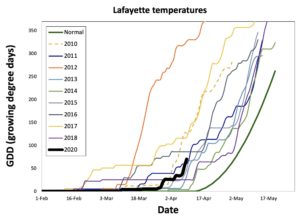It can be useful to compare this growing with previous years. The typical way we calculate growing conditions is by calculating Growing Degree Days (GDD). This is somewhat similar to the method many are familiar with for calculating codling moth emergence. In Figure 1, we see the accumulation of GDD over the last 10 years. What is labelled as “Normal” really isn’t that normal anymore. It’s the long-term average. Each of the last 10 years have been ahead of average. The year that stands out is 2012. Many will remember the especially early flowering time and a result of warm temperatures in March, and the subsequent freeze resulting in almost complete crop loss.
This year is marked with a heavy black line. We’re not especially early compared with the last few years. Those in southern Indiana, where peaches are towards the end of flowering and apples approaching full bloom, will be hoping for warm weather to favor pollination and early fruit growth. Growers in more northern areas of the state will be hoping for cool weather for another week or two to hold back development. With cooler weather forecast for the next week or so, it seems this won’t be an especially early year. As experience growers know, the later the spring the lower the chance of frost damage, but as these growers also know, you don’t want to count your chickens too early.
